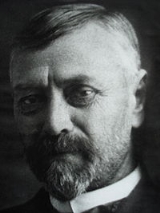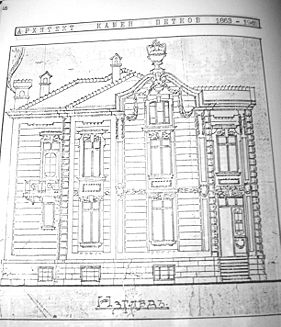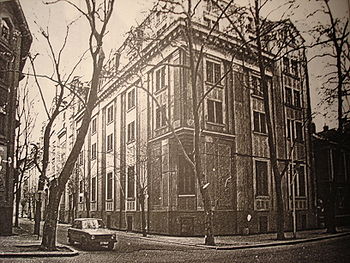
Kamen Petkov
Encyclopedia


Career
Arch. Kamen Petkov (1863, the region of BelogradchikBelogradchik
Belogradchik is a town in Vidin Province, Northwestern Bulgaria, the administrative centre of the homonymous Belogradchik Municipality. The town, whose name literally means "small white town," is situated in the foothills of the Balkan Mountains just east of the Serbian border and about 50 km...
, north-west of Sofia
Sofia
Sofia is the capital and largest city of Bulgaria and the 12th largest city in the European Union with a population of 1.27 million people. It is located in western Bulgaria, at the foot of Mount Vitosha and approximately at the centre of the Balkan Peninsula.Prehistoric settlements were excavated...
- 1945, Plovdiv) graduated from the Technical University of Karlsruhe (TH), Germany in 1896. Back in Bulgaria he worked for a short spell in Sofia where he collaborated, together with the painter Alexander Bozhinov Александър Божинов, in the “Balgaran” group. In 1898 he established his practice in Plovdiv and worked there for 47 years till his death in 1945.
He designed and built more than 800 buildings in Plovdiv alone. Most of them still shape the specific architecture of the city centre. Ten exquisite buildings can be seen along the Main Street alone, beginning with the powerful impact of the Bulgarian Bank (1898), and followed by smaller elegant buildings very much influenced by the Vienna Secession
Vienna Secession
The Vienna Secession was formed in 1897 by a group of Austrian artists who had resigned from the Association of Austrian Artists, housed in the Vienna Künstlerhaus. This movement included painters, sculptors, and architects...
architects. Their façades are lavishly decorated with fluted pilasters crowned with composite capitals; arched windows articulated by decorative columns, curvilinear ornaments and many other elegant details. Plant-inspired motifs such as blossoming small trees, ornamental garlands, festoons of flowers, etc., disclose a strong Art Nouveau
Art Nouveau
Art Nouveau is an international philosophy and style of art, architecture and applied art—especially the decorative arts—that were most popular during 1890–1910. The name "Art Nouveau" is French for "new art"...
influence.
In the French girls college, 1915 and boys college, 1932 respectively, however, he opted for a drastic geometric design. The contrasting frames of the shallow-arched windows and the dark highly stylized stucco pilasters create a strong graphic effect.
The four- and six-floor high tobacco warehouses are among Petkov's biggest works. The mansard above the main cornice is supported by massive consoles. Fluted risers articulate the large volumes into proportionate shapes. The design is an excellent mature integration of the functional and aesthetic aspects of a building for the industry.
In his early seventies Kamen Petkov won a competition organised by the Vatican
Holy See
The Holy See is the episcopal jurisdiction of the Catholic Church in Rome, in which its Bishop is commonly known as the Pope. It is the preeminent episcopal see of the Catholic Church, forming the central government of the Church. As such, diplomatically, and in other spheres the Holy See acts and...
among Bulgarian and Italian architects for the reconstruction and building of several Catholic churches in the region of Plovdiv which had been severely damaged in an earthquake in 1928. Thus he came to design the frontal part and the interior of the largest Catholic cathedral in the Balkan peninsula. This time he draws on the Italian neoclassicism. The main facade is very elaborate with six pairs of columns articulating the ground floor and four pairs above them emphasise the main entrance. Two cornices form the base of the frontón which is flanked by the statues of St. Peter and St. Paul and decorated with stylised floral forms.

During his long creative life Kamen Petkov left numerous lovingly designed buildings in a Bulgarian strain of the Art Nouveau
Art Nouveau
Art Nouveau is an international philosophy and style of art, architecture and applied art—especially the decorative arts—that were most popular during 1890–1910. The name "Art Nouveau" is French for "new art"...
movement which renders evident the ample extent and diversity of this ground-breaking phenomenon.

